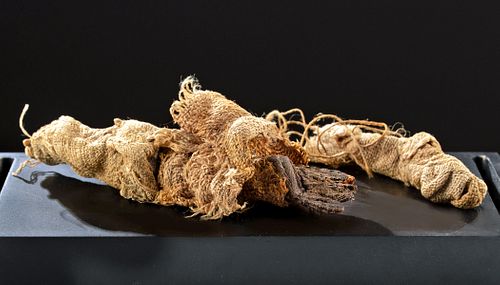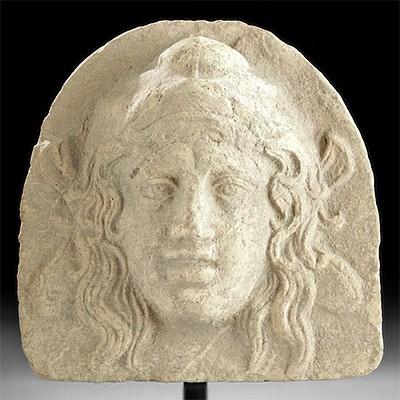Rare Egyptian Mummified Baby Crocodile Bundle w/ X-Ray
Lot 15
About Seller
Artemis Fine Arts
686 S Taylor Ave, Ste 106
Louisville, CO 80027
United States
Selling antiquities, ancient and ethnographic art online since 1993, Artemis Gallery specializes in Classical Antiquities (Egyptian, Greek, Roman, Near Eastern), Asian, Pre-Columbian, African / Tribal / Oceanographic art. Our extensive inventory includes pottery, stone, metal, wood, glass and textil...Read more
Categories
Estimate:
$900 - $1,400
Absentee vs Live bid
Two ways to bid:
- Leave a max absentee bid and the platform will bid on your behalf up to your maximum bid during the live auction.
- Bid live during the auction and your bids will be submitted real-time to the auctioneer.
Bid Increments
| Price | Bid Increment |
|---|---|
| $0 | $25 |
| $300 | $50 |
| $1,000 | $100 |
| $2,000 | $250 |
| $5,000 | $500 |
| $10,000 | $1,000 |
| $20,000 | $2,500 |
| $50,000 | $5,000 |
| $100,000 | $10,000 |
| $200,000 | $20,000 |
About Auction
By Artemis Fine Arts
Feb 27, 2020
Set Reminder
2020-02-27 10:00:00
2020-02-27 10:00:00
America/New_York
Bidsquare
Bidsquare : VARIETY SALE | Antiquities & Ethnographic Art
https://www.bidsquare.com/auctions/artemis-gallery/variety-sale-antiquities-ethnographic-art-4920
Around the world & back in time - be amazed at the treasures you will find. Antiquities from Egypt, Greece, Italy and the Near East, Asian, Pre-Columbian, African / Tribal / Oceanic, Native American, Spanish Colonial, Russian Icons, Fine Art, much more! Artemis Fine Arts info@artemisfinearts.com
Around the world & back in time - be amazed at the treasures you will find. Antiquities from Egypt, Greece, Italy and the Near East, Asian, Pre-Columbian, African / Tribal / Oceanic, Native American, Spanish Colonial, Russian Icons, Fine Art, much more! Artemis Fine Arts info@artemisfinearts.com
- Lot Description
Egypt, Late Dynastic Period, 26th to 31st Dynasty, ca. 664 to 332 BCE. A petite linen-wrapped mummified baby crocodile with a tightly wrapped body. The slender tail is disconnected from the back of the body, and the exposed back area of the crocodile reveals the clawed feet and even the individual scales on the skin. This is a votive mummy, a type that became popular especially after 664 BCE in 26th Dynasty. Egyptians bred millions of animals, including crocodiles, specifically to be mummified and offered to the gods with a prayer, often at yearly festivals centered around temples devoted to animal cults. Size of largest piece (body): 5.5" L x 1.625" W (14 cm x 4.1 cm).
The crocodile was, and still is, one of the most awe-inspiring creatures in the animal kingdom. The ancient Egyptians both feared and revered crocodiles for their stealthy nature as well as their ferocious killing capabilities. According to scholar Dorothea Arnold, "Although the ancient Egyptians somewhat whimsically called the crocodile 'wrinkle face,' without a doubt these reptiles were the most dangerous creatures of their country and a constant threat to the people and their livestock" (Arnold, Dorothea. "An Egyptian Bestiary." The Metropolitan Museum of Art Bulletin, Spring 1995, Vol. LII, no. 4, p. 32). Concurrently in regards to the crocodile-headed god Sobek, Egyptologist Garry J. Shaw explains that, "As a god, [Sobek] was associated with the riverbanks and the marshland, and in some sources the Nile was said to be his sweat . . . [though] not content to dwell just in the river, Sobek was also called the Lord of Bakhu, a mythological mountain in the horizon, where he lived in a temple made from carnelian" (Shaw, Garry J. "The Egyptian Myths: A Guide to the Ancient Gods and Legends." Thames & Hudson, London, 2014, p. 137).
Provenance: private J.H. collection, Beaverton, Oregon, USA, acquired in August 2014; ex-private Middletown, Rhode Island, USA collection; ex-Donald Tinney collection, Newport, Rhode Island, USA; ex-Sir Thomas Buxton collection, acquired around 1955
All items legal to buy/sell under U.S. Statute covering cultural patrimony Code 2600, CHAPTER 14, and are guaranteed to be as described or your money back.
A Certificate of Authenticity will accompany all winning bids.
We ship worldwide and handle all shipping in-house for your convenience.
#149830Tail separated from body. Fraying and loosening to some linen threads, with desiccation to exposed feet commensurate with age and mummification, and light staining to areas of linen. Great definition to exposed feet.Condition
- Shipping Info
-
All shipping is handled in-house for your convenience. Your invoice from Artemis Gallery will include shipping calculation instructions. If in doubt, please inquire BEFORE bidding for estimated shipping costs for individual items.
-
- Buyer's Premium



 EUR
EUR CAD
CAD AUD
AUD GBP
GBP MXN
MXN HKD
HKD CNY
CNY MYR
MYR SEK
SEK SGD
SGD CHF
CHF THB
THB


















